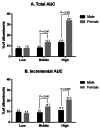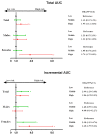Sex differences in impact of cumulative systolic blood pressure from childhood to adulthood on albuminuria in midlife: a 30-year prospective cohort study
- PMID: 37041564
- PMCID: PMC10088136
- DOI: 10.1186/s12889-023-15613-y
Sex differences in impact of cumulative systolic blood pressure from childhood to adulthood on albuminuria in midlife: a 30-year prospective cohort study
Abstract
Background and objectives: Albuminuria is recognized as being a predictor of cardiovascular and renal disease. We aimed to identify the impact of the long-term burden and trends of systolic blood pressure on albuminuria in midlife, as well as to explore sex differences concerning this relationship.
Methods: This longitudinal study consisted of 1,683 adults who had been examined 4 or more times for blood pressure starting in childhood, with a follow-up time period of 30 years. The cumulative effect and longitudinal trend of blood pressure were identified by using the area under the curve (AUC) of individual systolic blood pressure measurement with a growth curve random effects model.
Results: Over 30 years of follow-up, 190 people developed albuminuria, including 53.2% males and 46.8% females (aged 43.39 ± 3.13 years in the latest follow-up). The urine albumin-to-creatinine ratio (uACR) values increased as the total and incremental AUC values increased. Additionally, women had a higher albuminuria incidence in the higher SBP AUC groups than men do (13.3% for men vs. 33.7% for women). Logistic regression showed that the ORs of albuminuria for males and females in the high total AUC group were 1.34 (0.70-2.60) and 2.94 (1.50-5.74), respectively. Similar associations were found in the incremental AUC groups.
Conclusions: Higher cumulative SBP was correlated with higher uACR levels and a risk of albuminuria in middle age, especially in women. The identification and control of cumulative SBP levels from an early age may assist in reducing the incidences of renal and cardiovascular disease for individuals in later life.
Keywords: Albuminuria; Cumulative blood pressure; Middle-aged; Prospective studies; Sex characteristics.
© 2023. The Author(s).
Conflict of interest statement
The authors declare that they have no competing interests.
Figures




Similar articles
-
Cumulative Exposure to Systolic Blood Pressure During Young Adulthood Through Midlife and the Urine Albumin-to-Creatinine Ratio at Midlife.Am J Hypertens. 2017 May 1;30(5):502-509. doi: 10.1093/ajh/hpx012. Am J Hypertens. 2017. PMID: 28338726 Free PMC article.
-
Sex differences in impact of long-term burden and trends of body mass index and blood pressure from childhood to adulthood on arterial stiffness in adults: A 30-year cohort study.Atherosclerosis. 2020 Nov;313:118-125. doi: 10.1016/j.atherosclerosis.2020.10.003. Epub 2020 Oct 6. Atherosclerosis. 2020. PMID: 33045617
-
Associations of Long-Term Visit-to-Visit Blood Pressure Variability With Subclinical Kidney Damage and Albuminuria in Adulthood: a 30-Year Prospective Cohort Study.Hypertension. 2022 Jun;79(6):1247-1256. doi: 10.1161/HYPERTENSIONAHA.121.18658. Epub 2022 Apr 1. Hypertension. 2022. PMID: 35360932 Free PMC article.
-
Association of Longitudinal Trajectory of Albuminuria in Young Adulthood With Myocardial Structure and Function in Later Life: Coronary Artery Risk Development in Young Adults (CARDIA) Study.JAMA Cardiol. 2020 Feb 1;5(2):184-192. doi: 10.1001/jamacardio.2019.4867. JAMA Cardiol. 2020. PMID: 31734692 Free PMC article.
-
Increased Spot Urine Albumin-to-Creatinine Ratio and Stroke Incidence: A Systematic Review and Meta-Analysis.J Stroke Cerebrovasc Dis. 2019 Oct;28(10):104260. doi: 10.1016/j.jstrokecerebrovasdis.2019.06.018. Epub 2019 Jul 23. J Stroke Cerebrovasc Dis. 2019. PMID: 31350166
References
-
- Gerstein HC, Mann JFE, Yi QL, Zinman B, Dinneen SF, Hoogwerf B, Halle JP, Young J, Rashkow A, Joyce C, et al. Albuminuria and risk of cardiovascular events, death, and heart failure in diabetic and nondiabetic individuals. Jama-Journal of the American Medical Association. 2001;286(4):421–6. doi: 10.1001/jama.286.4.421. - DOI - PubMed
Publication types
MeSH terms
Substances
LinkOut - more resources
Full Text Sources

